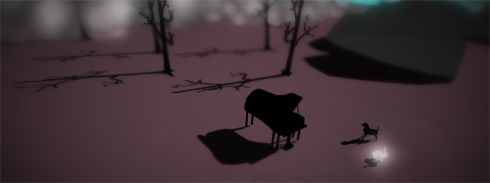Ruins, a free indie game by Jake Elliott of Cardboard Computer, is about many things---music, life, aging, relationships, dreams, art---all told through the perspective of a dog chasing rabbits in a dream. Best described as an "art game," Ruins is all about branching dialogue; the "story" shapes itself depending on how you respond in conversations. Respond with tired cynicism and the story becomes pessimistic; talk about things in your environment and the game explores those metaphors. You'll uncover different pieces of dialogue, depending on what you do, which makes the premise very intriguing as you start to figure out what's going on. All in all, Ruins is a delightful experience that you should consider checking out. More of my critique after the jump.
The visual style is very crisp with minimal use of color. The sky is a solid blue, the ground is some shade of mauve, and nearly everything else is shrouded in black, casting long shadows along the ground. The rabbits glow in a bright, white light that makes them stand out from the dark surroundings. On top of this is a slight motion-blur effect as the camera moves around. The visuals aren't especially remarkable, but they help establish the almost whimsical, dreamy atmosphere without being distracting.
The gameplay consists of trotting along looking for rabbits, which proves to be very relaxing. There was a lot of potential to make the gameplay more conventional by having the rabbits hide in obscure locations (like hide-n-seek), or turning it into a complicated game of tag or keep away. But these rabbits just kind of hop around aimlessly, making it fairly simple to just walk up to them, and the camera pans around well enough to let you find them easily. It's not the most engaging gameplay you'll ever see, but I appreciate its simplicity because it lets you focus more on the atmosphere and narrative, instead of getting hung up on gameplay. It also helps that the dog moves at a reasonable pace.
Music plays a prominent role in the atmosphere, as well as in the story. Both of the songs in the soundtrack are piano compositions by Frederic Chopin, who's referenced at least once. Like the visuals, the music selections are simple and effective. The title track (in A major) is soft and whimsical, while the in-game track (in A minor) is more somber and foreboding. One of the few major set-pieces in the environment is a piano, which further establishes the significance of Chopin's role in the metaphor.
As I've mentioned, the dialogue is the real selling point of Ruins. Each rabbit you speak to will ask you questions or give you opportunities to contribute to the conversation. You typically have two options that are closely related to each other but with slightly different tones. What you say ultimately steers the direction of what subsequent rabbits will talk to you about, meaning that different playthroughs can present different branching sequences where you learn more about different things.
Most other games with dialogue options don't actually present this level of sophistication, or at least distinction. Most of the dialogue options in a BioWare game, for example, only affect the order in which characters say things to you. In some cases what you say really doesn't matter because the game is designed to reach the same final destination, and what you say only causes minor deviations along the way. Whereas in Ruins, the dialogue is the entire vehicle of the narrative.
As is always the case with these kinds of "art games," I don't want to talk much about the content of the dialogue or the story, because the satisfaction of playing comes from figuring things out for yourself and coming up with your own interpretations along the way. Such questions as "Who am I? Where am I? What's going on? Who am I talking to?" are part of the mystery, and once you find answers to those questions, more questions layer on top of those. It proves to be rather engaging as you go along learning more about the premise and thinking about the game's deeper metaphors.
Ruins also packs a pleasing degree of emotional involvement into the experience. We all have a soft spot for animals, especially dogs, because they symbolize innocence. It's always sad when something happens to a dog in a movie, because they don't understand what's happening and most of the time they don't deserve it. But the dog in Ruins has just enough human characteristics (in terms of the way it thinks and sees the world) to make it endearing in a special sort of way, beyond the cliches of lovable dogs.
I would definitely recommend Ruins. It's relaxing with good emotional involvement, and its dialogue mechanics are satisfying to explore. The gameplay is functional and doesn't detract at all from the artistic experience. In fact, Ruins is a good example of an "art game" done properly that should be interesting even to someone who doesn't like typical art games. You can download Ruins for free on the Cardboard Computer posting.



No comments:
Post a Comment